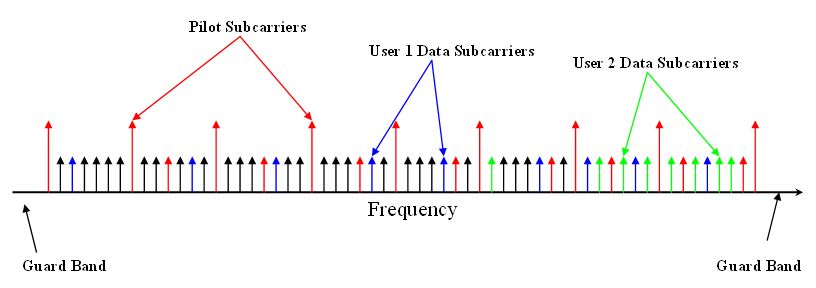|
Chrominance
Chrominance (''chroma'' or ''C'' for short) is the signal used in video systems to convey the color information of the picture (see YUV color model), separately from the accompanying Luma (video), luma signal (or Y' for short). Chrominance is usually represented as two color-difference components: U = B-Y, B′ − Y′ (blue − luma) and V = R-Y, R′ − Y′ (red − luma). Each of these different components may have scale factors and offsets applied to it, as specified by the applicable video standard. In composite video signals, the U and V signals modulate a color subcarrier signal, and the result is referred to as the chrominance signal; the Phase (waves), phase and amplitude of this modulated chrominance signal correspond approximately to the hue and Saturation (color theory), saturation of the color. In digital-video and still-image color spaces such as Y′CbCr, the luma and chrominance components are digita ... [...More Info...] [...Related Items...] OR: [Wikipedia] [Google] [Baidu] |
NTSC
NTSC (from National Television System Committee) is the first American standard for analog television, published and adopted in 1941. In 1961, it was assigned the designation System M. It is also known as EIA standard 170. In 1953, a second NTSC standard was adopted, which allowed for color television broadcast compatible with the existing stock of black-and-white receivers. It is one of three major color formats for analog television, the others being PAL and SECAM. ''NTSC color'' is usually associated with the System M; this combination is sometimes called NTSC II. The only other broadcast television system to use NTSC color was the System J. Brazil used System M with PAL color. Vietnam, Cambodia and Laos used System M with SECAM color – Vietnam later started using PAL in the early 1990s. The NTSC/System M standard was used in most of the Americas (except Argentina, Brazil, Paraguay, and Uruguay), Myanmar, South Korea, Taiwan, Philippines, Japan, and some Pacific Isl ... [...More Info...] [...Related Items...] OR: [Wikipedia] [Google] [Baidu] |
Analog Television
Analog television is the original television technology that uses analog signals to transmit video and audio. In an analog television broadcast, the brightness, colors and sound are represented by amplitude, instantaneous phase and frequency, phase and frequency of an analog signal. Analog signals vary over a continuous range of possible values which means that electronic noise and interference may be introduced. Thus with analog, a moderately weak signal becomes Noise (video), snowy and subject to interference. In contrast, picture quality from a digital television (DTV) signal remains good until the signal level drops below digital cliff, a threshold where reception is no longer possible or becomes intermittent. Analog television may be wireless (terrestrial television and satellite television) or can be distributed over a cable network as cable television. All broadcast television systems used analog signals before the arrival of DTV. Motivated by the lower bandwidth requ ... [...More Info...] [...Related Items...] OR: [Wikipedia] [Google] [Baidu] |
Chroma Subsampling
Chroma subsampling is the practice of encoding images by implementing less resolution for Chrominance, chroma information than for luma (video), luma information, taking advantage of the human visual system's lower acuity for color differences than for luminance. It is used in many video and still image encoding schemesboth analog and digitalincluding in JPEG encoding. Rationale Digital signals are often compressed to reduce file size and save transmission time. Since the human visual system is much more sensitive to variations in brightness than color, a video system can be optimized by devoting more bandwidth to the luma (video), luma component (usually denoted Y'), than to the color difference components Cb and Cr. In compressed images, for example, the 4:2:2 Y'CbCr scheme requires two-thirds the bandwidth of non-subsampled "4:4:4" R'G'B'. This reduction results in almost no visual difference as perceived by the viewer. How subsampling works The Visual perception, human vi ... [...More Info...] [...Related Items...] OR: [Wikipedia] [Google] [Baidu] |
SECAM
SECAM, also written SÉCAM (, ''Séquentiel de couleur à mémoire'', French for ''sequential colour memory''), is an analog color television system that was used in France, Russia and some other countries or territories of Europe and Africa. It was one of three major analog color television standards, the others being PAL and NTSC. Like PAL, a SECAM picture is also made up of 625 interlaced lines and is displayed at a rate of 25 frames per second (except SECAM-M). However, due to the way SECAM processes color information, it is not compatible with the PAL video format standard. SECAM video is composite video; the luminance (luma, monochrome image) and chrominance (chroma, color applied to the monochrome image) are transmitted together as one signal. All the countries using SECAM have either converted to DVB, Digital Video Broadcasting (DVB), the new pan-European standard for digital television, or are currently in the Digital television transition, process of conversion. S ... [...More Info...] [...Related Items...] OR: [Wikipedia] [Google] [Baidu] |
Color Burst
Colorburst is an analog and composite video signal generated by a video-signal generator used to keep the chrominance subcarrier synchronized in a color television signal. By synchronizing an oscillator with the colorburst at the back porch (beginning) of each scan line, a television receiver is able to restore the suppressed carrier of the chrominance (color) signals, and in turn decode the color information. The most common use of colorburst is to genlock equipment together as a common reference with a vision mixer in a television studio using a multi-camera setup. Explanation In NTSC, its frequency is exactly 315/88 = 3.579 MHz with a phase of 180°. PAL uses a frequency of exactly 4.43361875 MHz, with its phase alternating between 135° and 225° from line to line. Since the colorburst signal has a known amplitude, it is sometimes used as a reference level when compensating for amplitude variations in the overall signal. SECAM is unique in not having ... [...More Info...] [...Related Items...] OR: [Wikipedia] [Google] [Baidu] |
Composite Video
Composite video, also known as CVBS (composite video baseband signal or color, video, blanking and sync), is an analog video format that combines image information—such as brightness (luminance), color (chrominance), and synchronization, into a single signal transmitted over one channel. It is most commonly used for standard-definition television, and is sometimes referred to as ''SD video''. The signal is typically carried on a yellow RCA connector, with separate connectors used for left and right audio channels. In professional equipment, a BNC connector is often used instead. Other connector types may appear in compact consumer devices like digital cameras. Composite video supports several line resolutions, including 405-line, 525-line, and 625-line interlaced formats. It exists in three major regional variants based on analog color encoding standards: NTSC, PAL, and SECAM. The same format can also be used to transmit monochrome (black-and-white) video. Signal comp ... [...More Info...] [...Related Items...] OR: [Wikipedia] [Google] [Baidu] |
Video
Video is an Electronics, electronic medium for the recording, copying, playback, broadcasting, and display of moving picture, moving image, visual Media (communication), media. Video was first developed for mechanical television systems, which were quickly replaced by cathode-ray tube (CRT) systems, which, in turn, were replaced by flat-panel displays of several types. Video systems vary in display resolution, Display aspect ratio, aspect ratio, refresh rate, color capabilities, and other qualities. Analog and digital variants exist and can be carried on a variety of media, including radio broadcasts, magnetic tape, optical discs, Video file format, computer files, and Streaming media, network streaming. Etymology The word ''video'' comes from the Latin verb ''video,'' meaning to see or ''videre''. And as a noun, "that which is displayed on a (television) screen," History Analog video Video developed from facsimile systems developed in the mid-19th century. Early mecha ... [...More Info...] [...Related Items...] OR: [Wikipedia] [Google] [Baidu] |
Video Signal
Video is an electronic medium for the recording, copying, playback, broadcasting, and display of moving visual media. Video was first developed for mechanical television systems, which were quickly replaced by cathode-ray tube (CRT) systems, which, in turn, were replaced by flat-panel displays of several types. Video systems vary in display resolution, aspect ratio, refresh rate, color capabilities, and other qualities. Analog and digital variants exist and can be carried on a variety of media, including radio broadcasts, magnetic tape, optical discs, computer files, and network streaming. Etymology The word ''video'' comes from the Latin verb ''video,'' meaning to see or ''videre''. And as a noun, "that which is displayed on a (television) screen," History Analog video Video developed from facsimile systems developed in the mid-19th century. Early mechanical video scanners, such as the Nipkow disk, were patented as early as 1884, however, it took sev ... [...More Info...] [...Related Items...] OR: [Wikipedia] [Google] [Baidu] |
Subcarrier
A subcarrier is a sideband of a radio frequency carrier wave, which is modulated to send additional information. Examples include the provision of colour in a black and white television system or the provision of stereo in a monophonic radio broadcast. There is no physical difference between a carrier and a subcarrier; the "sub" implies that it has been derived from a carrier, which has been amplitude modulated by a steady signal and has a constant frequency relation to it. FM stereo Stereo broadcasting is made possible by using a subcarrier on FM radio stations, which takes the left channel and "subtracts" the right channel from it — essentially by hooking up the right-channel wires backward (reversing polarity) and then joining left and reversed-right. The result is modulated with suppressed carrier AM, more correctly called sum and difference modulation or SDM, at 38 kHz in the FM signal, which is joined at 2% modulation with the mono left+right audio (which ... [...More Info...] [...Related Items...] OR: [Wikipedia] [Google] [Baidu] |
JPEG
JPEG ( , short for Joint Photographic Experts Group and sometimes retroactively referred to as JPEG 1) is a commonly used method of lossy compression for digital images, particularly for those images produced by digital photography. The degree of compression can be adjusted, allowing a selectable trade off between storage size and image quality. JPEG typically achieves 10:1 compression with noticeable, but widely agreed to be acceptable perceptible loss in image quality. Since its introduction in 1992, JPEG has been the most widely used image compression standard in the world, and the most widely used digital image format, with several billion JPEG images produced every day as of 2015. The Joint Photographic Experts Group created the standard in 1992, based on the discrete cosine transform (DCT) algorithm. JPEG was largely responsible for the proliferation of digital images and digital photos across the Internet and later social media. JPEG compression is used in a number of ... [...More Info...] [...Related Items...] OR: [Wikipedia] [Google] [Baidu] |








